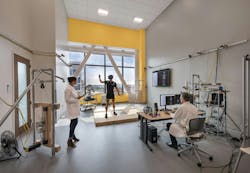University design to help meet the demand for health professionals
Virginia Commonwealth University is a Page client, and the Dean of the College of Health Professions took time to talk about a pressing healthcare industry need that schools—and architects—can help address.
Susan Parish, MSW, PhD, explained, “As a public institution, VCU is a powerhouse urban research university with longstanding commitments to supporting students from all backgrounds,” she says. “We have many first-generation college students. I deeply believe in our mission of giving all students access to excellence.”
As dean of the College of Health Professions, Parish leads a team of faculty and staff who are “creating new knowledge as they educate students” in physical therapy, nurse anesthesia, health administration, rehabilitation and mental health counseling, patient counseling, occupational therapy, clinical lab sciences, gerontology, radiation sciences, and interdisciplinary health sciences.
Parish says looming workforce shortages in health care require building up the pipeline of interested students prepared to enter the field and serve patients and communities. “Healthcare workforce shortages didn’t start with COVID and aren’t going to end when COVID ends,” she says.
Healthcare University Design Considerations
She stressed three things to know about preparing students for careers in healthcare, one of which influences design thinking of academic healthcare projects:
1. Plenty of jobs are available right now in healthcare professions—and more are coming
Overall employment in health care is projected to grow 13% over the next decade, resulting in about two million new jobs. Healthcare worker shortages continue to be a concern throughout the United States.
“The challenge we face is that we can’t graduate students fast enough to keep up with demand from the healthcare sector,” Parish says. “In most of our departments, 100% of our students have jobs within two to three months of graduation—some before graduation.”
2. To meet demand, health professions students must receive support
“The thing that keeps me up at night is the affordability of our programs. I am constantly looking for ways to reduce the cost and burden for our students,” says Parish. “Many of our students don’t have significant resources. It’s expensive to attend college and graduate school. We need to make it possible for our students to graduate without massive debt. I’m inspired by our alumni and friends who create scholarships and make it possible for some of our students to pursue their dreams of becoming health professionals.”
3. The best way to teach health professionals is by fostering collaboration and innovation
Just as health professionals work together to provide integrated care, health professions students should learn together as well, says Parish. VCU’s new Health Professions building co-locates the college’s academic programs for the first time.
“We use our new building as a platform not only to provide interprofessional education but to increase research spanning multiple disciplines,” says Parish.
Tech transformation for patients and professionals
Technologies such as the simulation labs and virtual reality tools have transformed how students are trained, says Parish. “Our building includes patient rooms, a full apartment, two operating rooms, two recovery rooms. This variety of classrooms enable students to experiment and make mistakes, learn from them, and perfect their skills before clinical rotation and delivering care to real patients.”
The College’s “smart apartment” includes a kitchen, bathroom, bedroom, and living room, and allows occupational therapy and gerontology students to learn how to enable people with functional disabilities and impairments to be as independent as possible, using adaptive equipment. “For example, an elderly person struggling with arthritis who can’t open the blinds can be more independent with technology that accomplishes the task for her,” Parish says. “The apartment is fully connected to smart devices, so the blinds, lights, and TV all are voice activated.”
The pandemic accelerated the use of telemedicine, she says, so training of students now includes content on how to provide care at a distance.
Another component is distance learning. “We use technology to teach students not on campus in synchrony with our on-campus students,” she says. For instance, the College has medical laboratory science students in Abingdon, Va., who participate in the classroom remotely. “The two-way, interactive connection allows active participation in class, with students working in labs both in Richmond and Abingdon,” she says. “Health systems in rural locations have been hit especially hard with workforce shortages, so training folks from those communities is vital.”
The Partnership
Page was the architect for Virginia Commonwealth University’s $87.3-million, eight-level College of Health Professions Building, which opened in 2019 and allowed the college to bring all its academic health programs under one roof for the first time. Page also was the architect for VCU’s Brandt Hall and renovations on Hibbs Hall and the Hunton Student Center.

